Inverness Deanery
Petty
Parish Church: OS Ref: NGR NH 739499 H.E.S. No: NH74NW 55 Dedication: St Columba
Associated Chapels: Alturlie {NGR NH 715495}.
It can not be doubted that the lands of Petty have a very old pedigree indeed, going back certainly to the Norman era, and most probably even further back to to Pictish times. The senior line of the family of 'de Moravia' tooks its name from Petty, showing that these lands were, perhaps, amongst the earliest held by that famous family. A little to the west of the present church building is what is thought to be a motte
There has always been a tradition of a Columban muinntir at Alturlie (Alterlie) Point
From as far back as the prehistoric period, there is a wealth of evidence from places such as Allanfearn and Cullernie which reveals that there was a significant population living on these shores and in the hinterland. It would not be at all surprising, therefore, if there were to be a muinntir found hereabout. Whether there was an association with Hy (Iona) or not is a matter for debate.
There was certainly a church here in the early medieval period. A charter of Pope Innocent III to the Abboot (Henry) of Arbroath Abbey lists the abbey's possessions. Amongst these, note is made of the gift by Richard, bishop of Moray, of "the church of Inverness with the chapel of Petty".3 But it is also on record that the church of Inverness, including its chapels (including Petty), were actually gifted to Arbroath by King William I at some date between 1189 and 1194,4 so the action of the bishop was possibly to confirm the king's gift. Note that, in both cases, Petty is called a 'chapel' and not a 'church'. However, whatever its status in 1200, by c.1224 it was certainly a parish church since its parsonage revenues (with those of Brachelie) were planned to be annexed by the bishop, Andrew de Moravia, to provide the endowment for a new canonry in the cathedral at Elgin.5 The bishop had obtained permission for the creation of this canonry from Pope Honorius III during his visit to the Vatican in 1224.6 It would appear, that at some point thereafter, the vicarages of the two churches were united to create a single cure.7 The bishops seem to have retained only a small amount of land in the parish at Meikle and Little Aldturleyis, but along with the property went the sea-fishings which would have provided a reasonable income.
The canon of Petty had a house within the Chanonry at Elgin, Petty Manse, which he held along with a garden and nearby croft.
The church has for long contained the burial ground of the Mackintosh Chiefs. The mausoleum is today in a much better state of repair than it had been. Sometimes known as the 'Mackintosh Vault', it was the legacy of Lachlan Mackintosh of Kinrara, the second son of Sir Lachlan, the 17th Chief, and the writer of the history of his family known as the Kinrara MS. In his will, dated 22nd November, 1686, he leaves "five hundred marks money to be wared (used) for building and erecting ane Chapel of esslar work at the easter gable of the Kirk of Pettie to be ane burial place for the Lairds of McIntoshe, their ladies and such others of the surname of McIntosh as are descended (or shall descend) of Umquhill Sir Lauchlan McIntoshe, his offspring." And in order that the work should not be delayed, it was stipulated that it should be erected within eighteen months after his decease, which took place in December, 1686. Mackintosh of Kinrara, in the same will, expressed the desire that he should be buried amongst his nearest relations within the Church of Petty, so it appears the Mackintosh family were, previous to the erection of the mausoleum, interred within the Kirk itself.
The Fishertoun of Petty
There was, at one time, a strange funeral custom at Petty. It came to be known as the Petty Step. It is said that it was the custom of the people of Petty to run (not walk) to funerals. The origin of the custom is traceable to the ancient superstition that the spirit of the last person interred in the graveyard had to keep watch and ward at the kirkyard gate until relieved by the subject of the next funeral! When two funerals took place on the same day, it was deemed lucky to be the first to cross the threshold, hence the haste sometimes encountered at Petty funerals. Apparently, the custom was given up by 1841 owing to some of the bearers tripping whilst carrying the coffin of an old reputed witch-woman to the churchyard. It was feared that her curse might fall upon them!
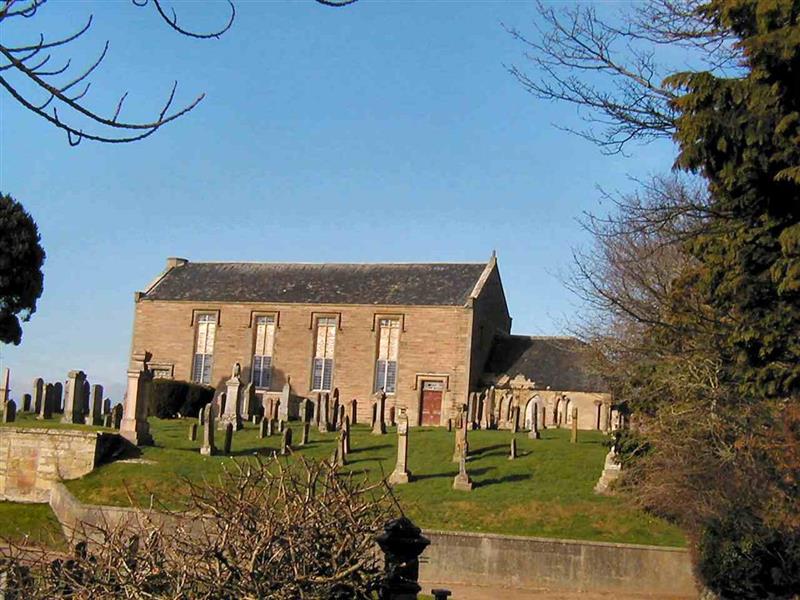
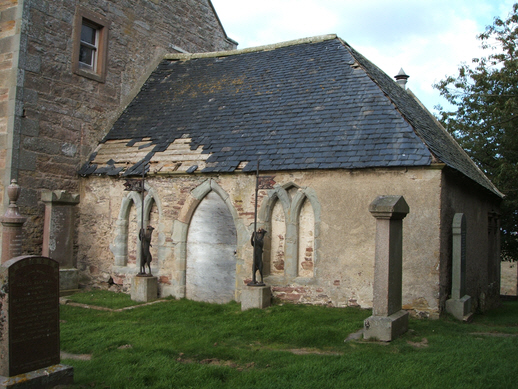
Above: Views of the Old Church and Churchyard of Petty.
(Note the two heraldic 'Cats' of the Clan Chattan on either side of the door of the mausoleum.)
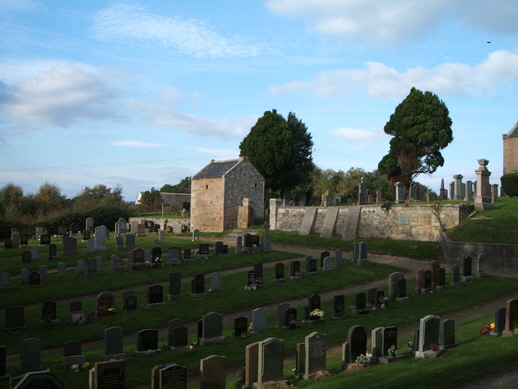
Above: The Watch House in Petty churchyard.
| Name | OS Grid Ref. | Extent | Comment |
|---|---|---|---|
| Nether & Over Cullernies | NH 724481/734475 | 1 dabhach | |
| Ourlarrust | 2 dabhaichean | under Dalcross Airfield? | |
| Flemingtoune | NH 802537 | 1 dabhach | |
| Dallasfield | 4 arratras | Croft McMartin | |
| Braichlie | NH 803521 | 1 dabhach | Easter & Wester Braichlie (Bellalaggan NH 794526) |
| Connage & Kerrogair | NH 777532 | 3 ploughgates | possibly a dabhach | Ross (2003)9, with OS Refs added by David de Moravia |
Other Churches and Chapels in the parish.
Alturlie Point - St Columba's Chapel. It is recorded that there was a burial-place at Alturlie
Parish Clergy:
1208 Walter, vicar of Petty, signs as witness the Magna Carta of bishop Bricius.11
1227 (March) Willelmus, canon of Petty, signs as witness a charter whereby bishop Andrew confirms the garbal teinds of the church of Abertarff to Beauly Priory, along with the teinds of salmon from all fisheries in the parish, which had been given by William Bisset that same year.12
1232 (26 July) William, canon of Petty, signs as witness a charter of Andrew, bishop of Moray, giving the lands of Dolays Mychel (Dallas) in feu and heritage to Donnchad, son of Gillemichel Macathhas (Duncan, son of Gilla Míchéil mac Áeda).13
1232 (11 October) R., vicar of Petty, signs as witness a charter of Andrew, bishop of Moray, whereby, with the advice and consent of the chapter and the assent of the clergy of the diocese, he decrees that teinds which have been received from a church for the previous forty years without interruption shall not be the subject of litigation in the future.14
1237 (10 October) William, canon of Petty, signs as witness a charter of bishop Andrew, granting to Walter de Moravia a site for a mill on the River Lossie in the bishop's lands of Uchtyrspyny by the eastern part of the "rogi" {?wood-pile/beacon} which is in that land, for the payment at Pentecost of 1lb pepper and 1lb cumin. Given 6 Ides October, 1237.15
1238 (5 March) Hugh, canon of Petty, signs as witness a charter of the dean and chapter of the cathedral detailing measures to be taken to discipline and punish the vicars of the cathedral for their shortcomings and misdeeds - absence from the canonical hours and celebration of the Mass.16
1431 (15 March) Since rectory of St Medulph {Kilmalie in Lochaber}, Argyll diocese, of lay patronage, is void because Colin Macheachyerna who obtained collation possessed it peaceably for a year and more without having himself promoted to the priesthood (there being no legitimate impediment), and, after the lapse of the above year, has detained it for almost three years without canonical title. Therefore, David de Pety, vicar of the united parish churches of Pety and Brachelyn, Moray diocese, B.Dec., present in Curia, supplicates that the Pope would provide him to the said rectory with dependencies (value, 12 marks sterling), void as above or by non-promotion of Angus Donaldi, formerly rector, to priesthood within statutory time, or by his promotion to the church of Sodor and his consecration, or void by the death of John Martrachna, formerly claiming right in said rectory, or howsoever void, even if there be a suit thereanent between John and Colin and certain others: notwithstanding that David holds above vicarage of the united churches, and the canonry and prebend of Kylmiel (Kilmichael) in the church of Ross, anent which he is litigating in Apostolic Palace (£15 sterling): dispensing him that he may hold said vicarage, and another rectory or parish church for life with clause of exchange: notwithstanding that in the foresaid church of St Medulph a perpetual vicar is instituted by ordinary authority to minister 'in divinis'. Fiat ut petitur. G. (This is a classical example of a clergyman trying to better himself by engaging in pluralism.)17
1431 (17 April) David de Petyn, priest, Moray diocese, B.Dec., vicar of annexed churches of Petyn and Brachlyn [Moray diocese], represents that the canonry and prebend of Logymecht in church of Ross, which at present Richard Stag, clerk, has occupied for a year and more by ordinary authority, is void in as much as Thomas de Urqward, now married, held it for some years, and John de Montealto for some time after him, against a statute published by the church of Ross and approved by Apostolic See, forbidding that anyone should be admitted to any prebend if he were not in holy orders or at least had himself promoted within a year to holy orders, the said Thomas holding for more than five years but John for his whole life time without being promoted, and now said Richard has held it for a year and more without being promoted. David supplicates that the Pope would provide him to the said canonry and prebend (value, £10 sterling), notwithstanding that he holds the canonry and prebend of Kylmychel in said church (£6 sterling), anent which he is litigating in Apostolic Palace, which he offers to demit after peaceable assecution of foresaid canonry and prebend of Logymecheli. Concessum ut petitur. B.Graden. (A month later, David continues on his successful quest to gather more profitable appointments!)18
1431 (30 April) Reformatio - Formerly the Pope granted provision to David de Petyn, vicar of Petyn and Brachelyn, Moray diocese, B.Dec., of the rectory of the church of St Moldulf, Argyll diocese, of which the cure is exercised by a vicar. But by signature of supplication (Fiat ut petitur. G. ut petitur) the dispensation that David might hold the rectory along with vicarage for life was not granted owing to rules and restrictions of the Chancery. But the fruits of the vicarage (£6 sterling) and of the rectory, also of lay patronage (£8 sterling), are so scanty in these days on account of hardships or of wars that for three years they scarcely ammounted to £8 sterling, and the vicar is bound to afford hospitality to all comers according to the custom of the country, to pay epsicopal dues and support other burdens, so that from the remainder of the fruits he cannot be suitably sustained. David, who is in Curia and has sustained great labours and expenses, supplicates that Pope would give mandate to expedite letters with dispensation to hold the vicarage and the rectory together for life, with clause of exchange. Fiat ut petitur et dispensamus. G.19
It would have cost David a considerable amount of money to have his letters regarding these three 'supplicatons' expedited at the Curia, a point that he himself makes to add matter to his cause.
1489 (8 May) At a convocation it was decided that a fur cappa (hooded cape) should be provided to Adam Gordon, prebendary of Petty, but that he should also be required to see to the repair/building of his manse in the Chanonry of Elgin.20 Such cappae were commonly worn by Scottish canons as part of their choir robes. They were often made of grey fur and, as well as adding to the digity of their dress, they would have had a very practial advantage to help combat the cold environs of a Scottish cathedral. Two of the effigies in the Cathedral of St Mary and St Machar in Aberdeen, show a canon wearing such a cappa. Today, purple or red cappae, of a simplified form, are still worn by bishops and cardinals of the Roman Catholic Church.
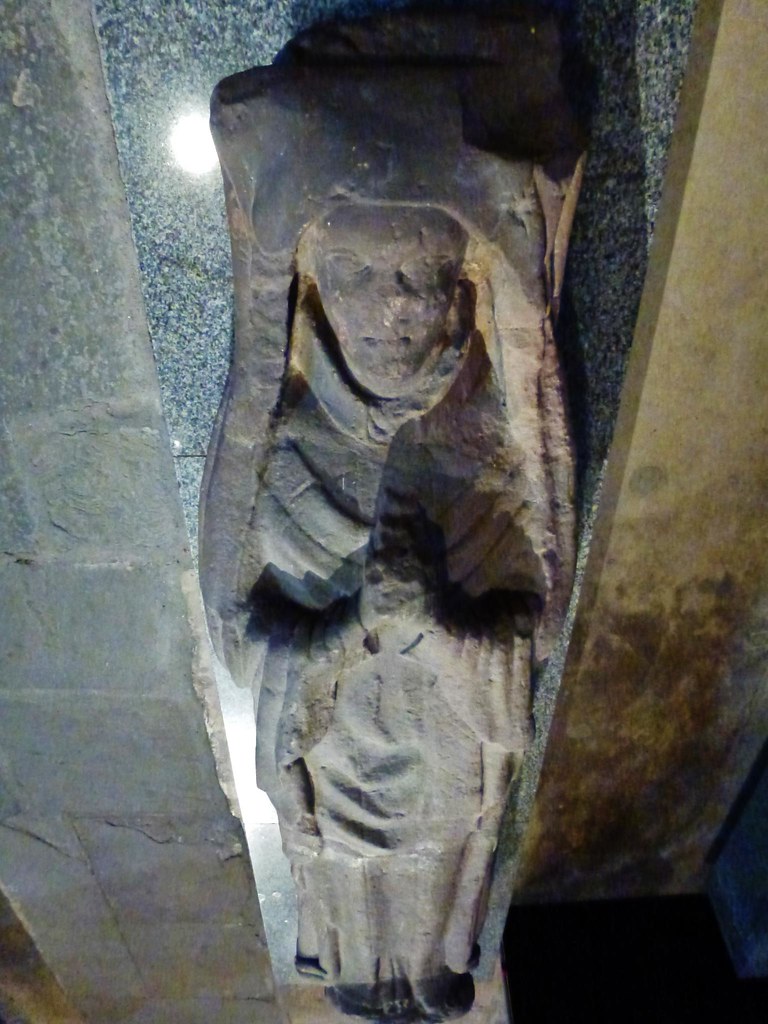
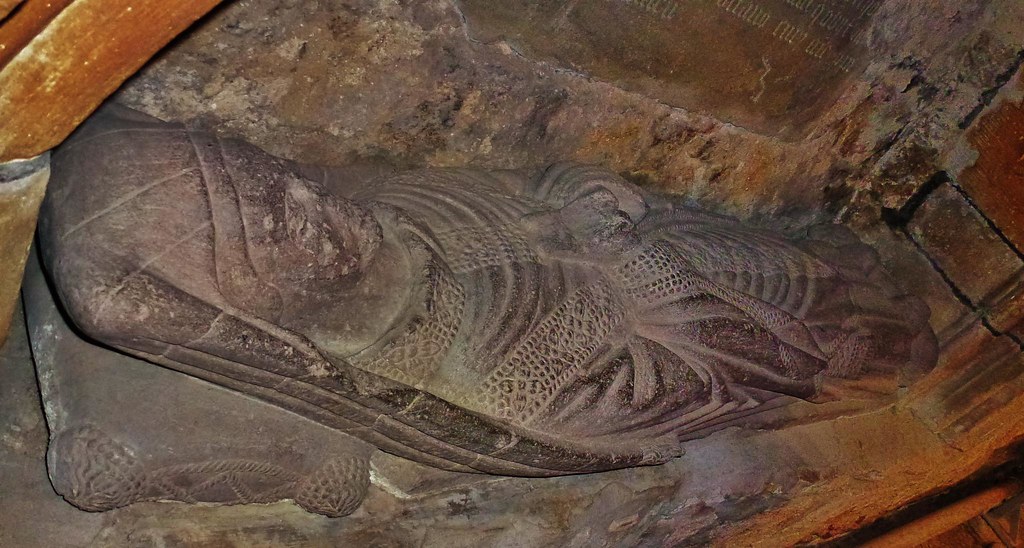
Above: Two effigies of canons wearing a cappa. (Aberdeen Cathedral)
1541 (7 May) John Ogilvie, prebendary of Petty, signs as witness a charter of Patrick, bishop of Moray and perpetual commendator of Scone Abbey, whereby he gives and lets heritably to William Grant, son of John Grant of Freuchie, the lands of Vuirfinlarg (Over Finlarg), alias Mukroth (Muckrach), and Nedirfinlarg (Nether Finlarg)
1. The items, which are believed to have been found in the vicinity of Castle Stuart, were claimed as Treasure Trove and are currently in Inverness Museum.
2. Ross, A (2003) The Province of Moray, c.1000-1230. PhD Thesis submitted to the University of Aberdeen, 2003. Vol.i, 89.
3. Arbroath Liber, no.221. Given at the Lateran, 26 April 1200.
4. R.R.S., ii, 357. Given at Montrose, with Richard of Lincoln, bishop of Moray, signing as one of the witnesses.
5. Moray Reg., 61.
6. Moray Reg., 67. Given at the Lateran, 20 April 1224.
7. Cowan, Parishes, 22.
8. Pryde, G S. (1965) The burghs of Scotland: a critical list. London. p.65, no. 288.
9. Ross, A (2003) The Province of Moray, c.1000-1230. PhD Thesis submitted to the University of Aberdeen, 2003. Vol.i, 88-89; Vol.ii, 81-82.
10. HES Canmore Database. http://canmore.org.uk/site/14207 (accessed 12/10/19)
11. Moray Reg., 46.
12. Batten, E C (1877) The Charters of the Priory of Beauly. London: Grampian Club. p.38. (Batten dates this charter to 1242 but it is signed by Richard, Precentor of Moray, who had been replaced by William by 1232, which gives a terminus ante quem of 1232.); Beauly Chrs., no.2 and 3.
13. Moray Reg., 79.
14. Moray Reg., 82.
15. Moray Reg., 121. The fact that this charter is also signed by Gregory, the master mason, and Richard, the master glazier, suggests that ist was signed within the cathedral that was being constructed in Elgin.
16. Moray Reg., 90.
17. Scottish Supplications to Rome, 1428-1432. CSSR, iii, p.166. Given at S. Apostoli, Rome.
18. CSSR, iii, p.178. Given at St Peter's, Rome.
19. CSSR, iii, p.181. Given at St Peter's, Rome.
20. Moray Reg., 210.
21. Fraser, Wm. (1883) The Chiefs of Grant, Edinburgh, vol.iii., no.290, p.367. Given in the Chapter House of Moray. http://archive.org/details/chiefsofgrantmv300fras
e-mail: admin@cushnieent.com
© 2019 Cushnie Enterprises
